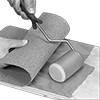Filter by
For Use On
Container Type
Color
Formulation
Maximum Temperature
Appearance
For Joining
Container Size
Solution Type
Consistency
Manufacturer
Touch Dry Time
Minimum Temperature
Primer Required for Use On
Manufacturer Model Number
Export Control Classification Number (ECCN)
DFARS Specialty Metals
Maximum Application Temperature
Facility and Grounds Maintenance
Fastening and Joining
Electrical







































